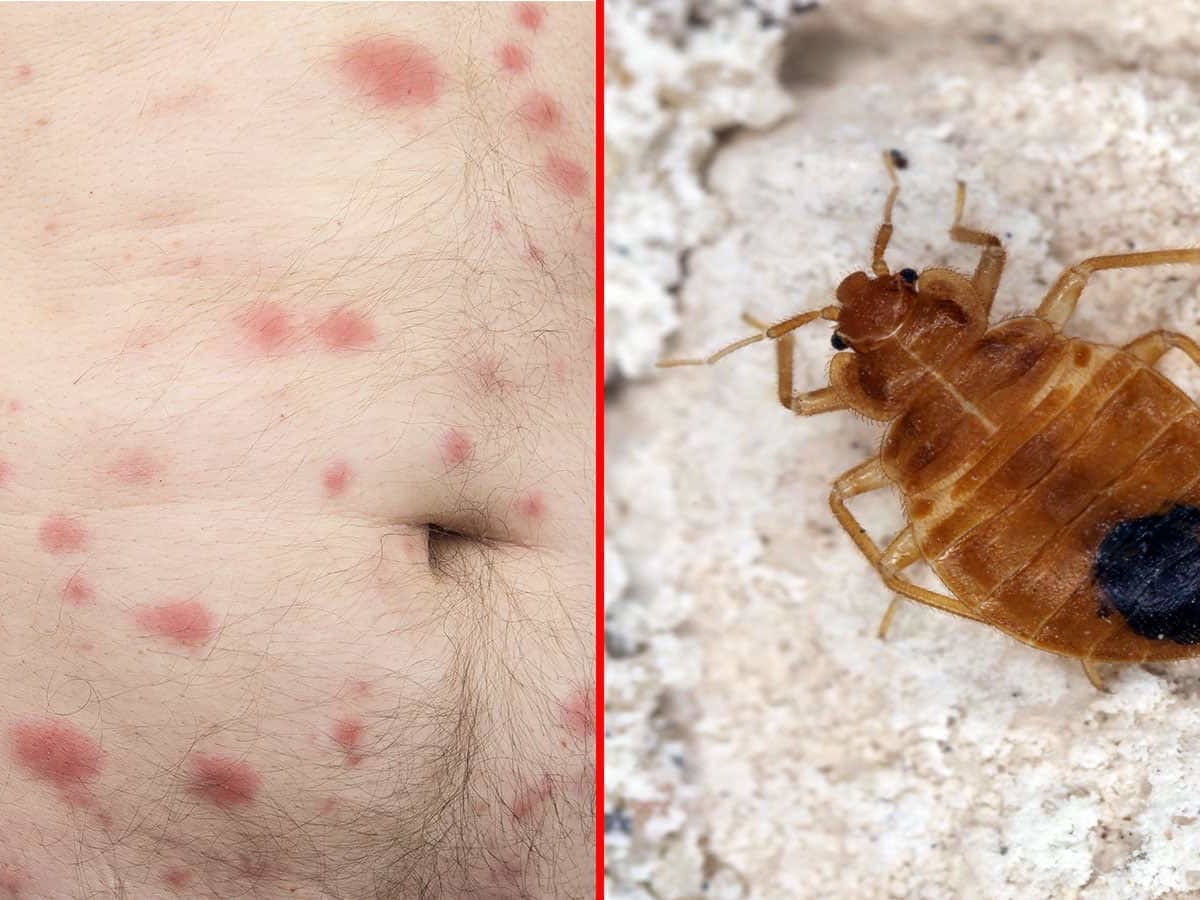If you think you might have bed bugs in your office, don’t panic. There are a few simple ways to check for these pests. First, look for signs of bed bug activity, such as small brown stains on sheets or furniture, molted skin shed by the bugs themselves, or tiny red spots of blood from bites.
If you see any of these signs, it’s time to do a more thorough inspection. Start by checking all the places where people sit or sleep in your offices, such as chairs, couches, and desks. Look for bed bugs in the cracks and crevices of furniture and along the seams of mattresses and cushions.
Also check behind picture frames, under loose wallpaper, and in any other dark hiding spots. If you have cubicles or partitions in your office, be sure to inspect them thoroughly as well since bed bugs can easily travel between them.
- Look for signs of bed bugs in the office, such as small brown spots on walls or furniture, or dark stains on mattresses
- Inspect any areas where people sit or sleep for evidence of bed bugs
- Check for bed bugs in common areas, such as conference rooms, break rooms, and lobbies
- If you suspect there are bed bugs in the office, contact a professional pest control company to confirm and treat the infestation

Credit: www.powerofpositivity.com
Are Bed Bugs Common in Offices?
No, bed bugs are not common in offices. While bed bugs can hitch a ride into any type of building on people or on belongings, they are most commonly found in homes and hotels. Bed bugs feed on human blood and prefer to hide in cracks and crevices near where people sleep, so they are less likely to be found in an office environment during the day.
However, if someone who has bedbugs brings them into an office on their clothing or personal belongings, it is possible for the pests to infest the area. If you think you may have spotted a bed bug in your office, contact a professional pest control company for assistance.
Can Bed Bugs Survive in an Office?
If you’re dealing with a bed bug infestation at home, you may be wondering if these pests can also invade your workplace. Unfortunately, bed bugs are good at hitchhiking and can easily spread to other areas, including offices. Here’s what you need to know about bed bugs in the office and how to prevent an infestation.
Can Bed Bugs Survive in an Office?
Bed bugs are small, reddish-brown insects that feed on blood. They are attracted to warmth and carbon dioxide, which is why they often bite people while they sleep.
Although bed bugs don’t carry diseases, their bites can be uncomfortable and cause swelling, itching, and redness.
Bedbugs are hardy creatures and can survive in a wide range of environments. They can go without food for several months and can withstand extreme temperatures (from nearly freezing to over 122 degrees Fahrenheit).
This means that bedbugs could potentially survive in an office environment.
However, it’s important to note that bedbugs are not typically found in offices. These pests prefer places where people sleep or rest for long periods of time, such as homes, hotels, and shelters.
But there have been a few cases of office infestations reported across the country. In most cases, these infestations were caused by someone bringing bedbugs into the workplace from another location (such as their home or a hotel room).
Is There a Device to Detect Bed Bugs?
There are several devices on the market that claim to detect bed bugs. However, there is no scientific evidence that any of these devices are effective in detecting bedbugs. Bed bugs are small, elusive creatures and can be difficult to detect with the naked eye.
The best way to detect bedbugs is to look for signs of infestation, such as bites on the skin, shed skin, or bloodstains on sheets or mattresses. If you suspect you have a bedbug problem, it is best to contact a professional pest control company for assistance.
How Do I Know If My Office Chair Has Bed Bugs?
If you think you might have bed bugs in your office chair, there are a few things you can look for to be sure. Check for small, reddish-brown bugs about the size of an apple seed. These are bed bugs in their adult form and they’re most likely to be found near where people sleep or sit for long periods of time.
Try lifting up the cushions on your chair and looking in the cracks and crevices for any sign of these critters.
Another way to tell if you have bedbugs is by looking for tiny brown stains on your sheets, pillowcases, or clothing. These are droppings from the insects and will often be found in groups of three.
If you see these stains, it’s a good indication that you have a problem with bedbugs.
Finally, pay attention to any bites you may have on your body. Bedbugs feed on human blood and their bites can cause red, itchy welts on the skin.
If you wake up with bite marks that weren’t there when you went to sleep, it’s possible that bedbugs are responsible.
If you suspect that your office chair has bedbugs, don’t panic! These pests can be difficult to get rid of but it is possible with the help of a professional exterminator.
Contact a company specializing in bedbug removal and they’ll be able to get rid of the problem quickly and efficiently.
How Likely is It to Get Bed Bugs from a Coworker?
There’s no doubt that bed bugs are a major nuisance. But how likely is it that you’ll get them from a coworker?
Unfortunately, it’s not uncommon for bed bugs to spread in the workplace.
They can hitch a ride on clothing or personal belongings and be transported from one person to the next.
If you have a coworker who is dealing with a bed bug infestation, your risk of getting them increases. However, there are some things you can do to protect yourself.
First, be sure to keep your workspace clean and clutter-free. This will make it more difficult for bed bugs to hide and breed. Second, inspect your clothing and personal belongings regularly for signs of bedbugs.
And finally, if you suspect that your coworker has bedbugs, alert management so that they can take steps to resolve the issue.
What is the Best Way to Check for Bed Bugs?
If you think you may have bed bugs, the first step is to check for signs of the pests. Look for brown or red spots on your sheets, pillowcases, and mattress. You might also see small bloodstains on these fabrics.
Bed bugs can also leave behind dark fecal matter, which looks like black pepper.
Another way to check for bed bugs is to look for physical signs of the insects themselves. These pests are small, oval-shaped, and brown in color.
They typically measure between 4 and 5 mm in length. If you spot a bed bug, it’s important to capture it and place it in a sealed container so that an expert can identify it.
If you’re still not sure whether or not you have bedbugs, there are some other methods of detection that you can try.
One is to use a special light device that makes the insects easier to see. Another option is to hire a professional exterminator who will be able to confirm whether or not you have an infestation.
How to Detect Bedbugs in the Office
Bed Bugs in Office
Most people think of bed bugs as a problem that only affects homes, but these pests can also invade offices and other commercial buildings. Bed bugs are good at hiding and can easily go unnoticed in a busy office environment. These pests are often brought into an office on personal belongings or on visitors, and once they’re established, they can be difficult to get rid of.
Bed bugs feed on human blood and can bite people during the day or night. Although their bites are usually not dangerous, they can be very itchy and uncomfortable. Bed bug bites can also cause anxiety and sleeping problems for some people.
If you suspect that your office has bedbugs, there are a few things you can do to help control the problem:
– Inspect your office regularly for signs of bedbugs, such as small brown stains on walls or furniture, shed skin, or live insects.
– Encourage employees to keep their personal belongings off the floor and away from furniture where bedbugs could hide.
– Vacuum regularly and dispose of the bag immediately after each use.
Conclusion
If you think you might have bed bugs in your office, there are a few things you can do to check. First, look for small brown or red dots on your sheets, furniture, or walls. These may be bloodstains from crushed bugs.
Second, look for tiny white eggs or eggshells on surfaces near where you sleep or sit. Third, inspect any secondhand furniture carefully before bringing it into your office space. Finally, ask your coworkers if they’ve noticed anything unusual lately.
If anyone has bites or welts that could be from bed bugs, contact a professional pest control company right away.

